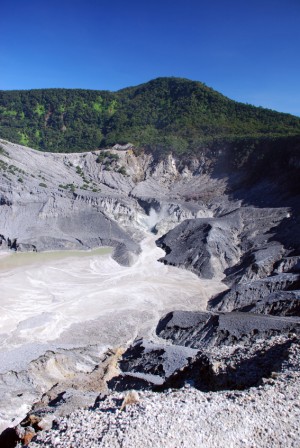A Place Beyond White Sands and Clear Oceans: Trekking Through Indonesia
Bandung on weekends is beset by countless Jakartans trying to beat the heat of their own city, and so the paved road up the volcano was full of slow-moving cars and motorcycles whizzing around them. I was frequently offered rides, but had no interest in being driven. Headphones still in, I’d tell the drivers that I intended to walk, making a walking motion with my fingers. The would-be good Samaritans would shrug in bewilderment before smiling and being re-absorbed by the traffic flow.
Walking up the side of the road, I noticed that the forest on either side was strangely reminiscent of an American forest – far fewer “tropical looking” trees than I had expected, which made sense given the climate. Still plunging deeper and deeper into the Dead set I’d started in the angkot, my mood was climbing as fast as my feet. I hate the hippy connotations of backpacking around and listening to the Grateful Dead, but I couldn’t have chosen a better musical accompaniment.
I felt vital, alive, happy, and confident in a way I think many of us don’t get to feel often enough. It was napalm in the morning — the happiness of conquest, live music, 3 a.m. golden drunks with dear friends, and moments of transcendent love. And with the exception of being drunk with friends, it was all of those things in its own way, thanks to my iPod and the copious amount of time given to reflect on my life and relationships. I was glad I had done this alone, allowing me to set my own pace and be with my thoughts, as I felt immediately in touch with the important people in my life despite the considerable distance.
About 2/3 of the way to the top crater, Kawah Ratu, there was a brief resurgence of rain, only now it took the form of the most gentle summer shower possible. At the elevation I had reached by then, it was impossibly refreshing.
The rain had stopped again by the time I reached the top, replaced by sporadic gusts of vicious wind. I walked partly around the massive crater, music now off, taking in the steam rising from the grey bottom, approximately some 6,500 feet below. It didn’t look dangerous, having been dormant since 1983, but the scarred, smoking base, certainly betrayed a history of rage and violence. The steam and smoke ascended lazily past thousands of feet of barren black rock before reaching higher altitudes, where they combined with post-rain fog to obscure the greener peaks in the distance. It was an impressive sight.
I stopped for a celebratory Bintang beer and some roasted corn, the first fresh corn I’d enjoyed in all my time in Asia (I spend most of my year in China, where corn is wretched in a way that’s hard to comprehend). Taking in my surroundings, I was again impressed by the casual friendliness of the Indonesian people. I helped groups of friends take pictures and had the favor returned, and was joined by a pair of college-aged brothers while I savored the second half of my beer and fought off the berserk fits of wind. We discussed everything from travel to aviation, and by the end, the older brother took down my e-mail on his Blackberry, the ubiquitous smart phone of choice in Indonesia.
From there it was all falling action as I began heading down. The adrenaline which had propelled me to the top was no longer necessary, and I had already peaked, both emotionally and geographically. I was coasting on the residual high of the climb, but there was still one more stop before calling it a day.
A kilometer down from Ratu is a secondary crater, Kawah Domas, which is more active and marked by bubbling pools of hot water and steaming vents. The walk there goes through the forest, and the deeper I got, the more it took a tropical feel.
The smell of sulfur heralded Domas, where Indonesian tourists soaked their feet in the pools and smeared themselves with the mineral-rich clay they scraped from the bottoms. Children getting the clay treatment playfully shouted “zumbi, zumbi,” a nod to the Indonesians’ love of horror and pervasive belief in the supernatural.
I didn’t linger too long, feeling a bit lonely in the face of all the groups of friends and family, and also fearing that staying too late would cause me to lose out on cheap angkot rides back to Bandung proper. By the time I reached the bottom, and had to walk to the nearest town, I was dead on my feet. I grabbed an angkot and ate the half-bag of Lays chips I had in my bag with an orange.
Perahu isn’t the world’s most challenging climb, nor is Bandung its most fascinating city. Yet together, they marked a literal and figurative high point in my vacation, a part of Southeast Asia that most of us never even consider in our dreams of white sands and clear oceans.


